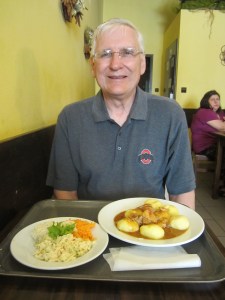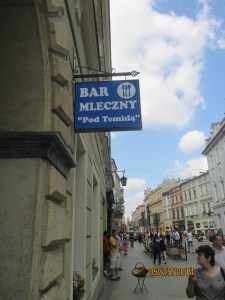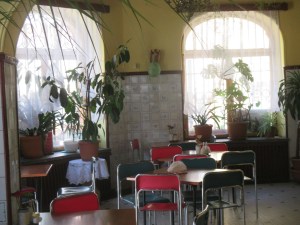In Poland, tourists won’t find milk bars in a “Top Ten Places to Go” list. Malbork Castle, the Salt Mines, Zakopane, and the Old Town in Krakow are all there, but milk bars (“bar mleczny” in Polish) should be near the top if you are seeking a unique experience not found anywhere else. Some refer to milk bars as “ Poland’s version of cheap fast food,” but it is more accurate to view them as “good traditional food served fast.”

Milk bars are very inexpensive restaurants found mostly in Poland’s larger cities and offer traditional polish cooking, just like your grandmother used to serve. The only difference is that the women servers in their flowered aprons won’t remind you of your sweet, solicitous grandma. These women are cooks, not chefs, are efficient and hard-working, but have a reputation for being impatient with those who don’t know how these cafeteria-like eateries work. Seinfeld’s hilarious episodes about the man referred to as “the Soup Nazi” in New York might be the closest comparison.*

History of Milk Bars
Milk bars have nothing in common with lounges and bars as you won’t find alcohol. The milk part of the name harkens back to their origins in urban dairies in the late 1800’s when the abundant supply of milk made it possible to help feed those on a very limited income. Early milk bar meals consisted of milk, egg, and flour-based foods and no meat
After WWII, when Poland was satellite country within the Soviet Union, milk bars became state-subsidized. Workers were quite poor but could find an inexpensive, hot meal at these eateries. There were more than 40,000 in their heyday, but the numbers shrank to about 140 by 2016.
Milk bars began closing after Poland gained total independence in the 1990’s and embraced capitalism. During these transition years, milk bars represented a holdover from the decades of communism and patronage fell into decline. Today, the younger Polish people aren’t burdened with memories of socialism, making milk bars popular with university students. The average Pole and lucky tourist will not find a better deal for dining.
Finding a Milk Bar
My favorite way to find the best milk bars and other inside information is to ask Trip Advisor Forum experts. These very knowledgeable and generous people will provide information for planning your trip or at the last minute “on the ground” (where is a recommended milk bar in Krakow, Rzeszow, Warsaw, Gdansk, etc.? Where can I find a store in Krakow that sells Polish pottery? etc.).
You will find milk bars in the large cities in Poland but not in the smaller towns. If you haven’t received recommendations, Google map your city and then search with the term “bar mleczny” (milk bar). Cities such as Krakow and Warsaw have quite a few so check out the reviews.

You will discover there are two types of milk bars: government subsidized and not subsidized. Neither is necessarily better than the other, but the ones who rely on government subsidies have their prices with odd numbers in the ones or cents place. These eateries, likely the less expensive of the two choices, change their prices based on the current costs. The menu and prices on a chalkboard, whiteboard or similar board is a clue.

The non-subsidized tend to keep their prices more stable, are slightly more expensive, and their prices are often listed in rounded up numbers: 9.50, 3.20, etc.
A new trend is what some refer to as “hipster milk bars.” Entrepreneurs often purchase milk bars that are going out of business and remodel them to make them more appealing. They often receive very good reviews with mention of friendly servers, nice atmosphere, table service, and the most important attribute: English speaking workers. The food tends to be a bit pricier, and you will find a menu with an international flare: Irish breakfast, crepes, lattes, paninis, etc. These restaurants are highly regarded by many locals and maybe a great place to start your milk bar adventure.
Atmosphere
Depending on the milk bar’s popularity and the time of day, you can expect a relatively long line at lunchtime. The large menu on the wall will list the items in Polish and the price per serving. The interior will be low frills, usually metal-framed tables and chairs for 2 or 4 people, and minimal décor.


Milk Bars in Warsaw and in Krakow
The typical patrons are university students and professors, local workers, and pensioners. They order, eat, and leave since the ambiance doesn’t lend itself to leisurely dining. The expectation is to eat and move on.
Menu
Each milk bar is unique, but all the menu items are familiar to Poles and may not be in English. Milk bars that cater to tourists have the foods listed in Polish and English. There is nothing wrong with that if it encourages visitors to order. Some milk bars offer an English translation on paper without prices.


One of the best features of milk bars is that they serve fresh foods without artificial preservatives. Some favorite and traditional foods at a milk bar are:
Pierogi filled with meat, sauerkraut, mushrooms or potatoes and cheese.

Soups: Zurek (my favorite), barszcz, chicken noodle, mushroom, or tomato

Meat Dishes: breaded pork cutlet, fried chicken legs and thighs, beef roulades, golabki (stuffed cabbage), and Bigos.

Sides: potatoes, sauerkraut, small salads such as coleslaw, cucumber salad, or mixed vegetables, potato pancakes, and bread

Beverages: coffee, tea, Kefit, or kompot (homemade fruit juices made with fruit, sugar, and raisins)
Desserts: Apple cakes, cheesecake, paczki, etc.
How to order:
Since milk bars are mostly cafeteria style, patrons will see the menu displayed above the serving or ordering area. Stand back and study it before you approach one of the servers.
The goal in ordering is to be quick and efficient. If you are a person with very limited Polish skills, study the menu and do a bit of translation. You might want to write down the food you desire before approaching the line and can ask other patrons for help. The younger people in Poland tend to have very good English skills. Many Poles in larger cities do speak some English, but the middle-aged and older populations were forced to learn Russian in school and often are not able to help.
Even if it is not reciprocated, smile while you order and start with “please” which is prosze (pronounced “proh-sheh”). Then say how many you want. You can also show the server with fingers, but it is preferable to learn the Polish number words:
- one (jeden, pronounced “yeh-den”)
- two (dwa, pronounced “dvah”)
- three (trzy, pronounced “chrih”)
Many milk bars now offer carryout for a small fee. The cashier may ask you “na miejscu? (pronounced nah myay stsu) which means “For Here?” If you are finished ordering, say either “Tak” for yes or “Nie” (neeyeh) for no and continue to order.
Some milk bars are just a cafeteria line with most of the food in steam trays, but most have windows for picking up the order. You will receive a receipt to hand to the worker at the window. Soups and drinks are served immediately, but there is some wait for the popular dishes like pierogi. You can take the ready items to a table and begin to eat while waiting for the rest of your food. Listen for your order to be announced and be sure to bring your receipt. Confirm that the order is yours.
The patrons are expected to dispose of their trash and return the dishes in the appropriate area.
Now that you have the basic strategies, you are equipped to partake in a bit of history not on most tourist’s radar. Enjoy your dining as a cultural adventurer!
Here is a menu and the 2017 prices from a milk bar in Gdansk
BREAKFAST PRICE
Scrambled eggs with 2 eggs 3,80 PLN
Fried egg PLN 1.50
Boiled egg PLN 1.10
Omelette with cream and sugar PLN 5.70
Roll of muesli 4.50 PLN
Roll with butter PLN 1.60
Poznan roll 3,90 PLN
A sandwich with 2.00 zlotys
Semolina 3.00 zlotys
Cottage cheese with cream and chives PLN 3.50
Herring in cream PLN 5.00
Poultry jelly 5,00 PLN
Vegetable salad PLN 3.50
Vegetable salad with whole egg, chives and mayonnaise PLN 5.00
Baked beans PLN 5.50
PLN 7.00
Fish in Greek 7.00 PLN
SOUPS PRICE
Ukrainian borsch 5.00 zlotys
Pea PLN 5.00
Bean 5.00 PLN
Vegetable PLN 4.00
Cabbage soup PLN 5.00
Cucumber 4.50 PLN
Tomato soup with pasta PLN 5.00
Chicken soup with pasta PLN 5.00
Cauliflower PLN 5.00
Sour soup PLN 5.00
Krupnik PLN 5.00
Mushroom PLN 4.00
Bean 5.00 PLN
Goulash PLN 6.50
Tripe PLN 6.50
Chłodnik PLN 6.50
Fruit with pasta PLN 3.50
MAIN DISHES WITH MEAT PRICE
Chicken in sweet and sour sauce 12.00 PLN
Dove with sauce PLN 7.00
Knuckle 100g 55 PLN / kg
Gypsy cake PLN 14.00
Turkey roast with mushrooms PLN 11.00
Pork goulash PLN 6.50
Poultry stew PLN 11.40
Dumplings with meat PLN 9.00
Meatballs in a sauce PLN 9.00
Cutlet devolaille PLN 9.50
Ground cutlet PLN 6.50
Pork chop PLN 8.50
Swiss pork chop PLN 9.50
Chicken breast cutlet PLN 8.00
Roast pork 8.00 PLN
Dumplings with meat 6 pcs. PLN 9.00
Chicken leg 50 PLN / kg
Pork rind 8.00 zlotys
Bigos PLN 5.50
Chicken liver 7.00 zlotys
MAIN DISHES WITHOUT MEAT PRICE
Pancakes with apples 2 pcs. PLN 6.00
Lazy with cream and sugar PLN 6.50
Pancakes with cream and sugar PLN 6.50
Pasties with egg 2 pcs. PLN 5.00
Patties with mushrooms 2 pcs. 7.00 PLN
Patties with cabbage and mushrooms 2 pcs. 7.00 PLN
Russian dumplings 6 pcs. 8.00 PLN
Fried fish 100 g. PLN 6.00
Potato pancake with mushroom sauce PLN 12.00
Dumplings PLN 4.00
EXTRAS PRICE
Potatoes PLN 3.00
French fries 150 g. PLN 4.50
Buckwheat 2.90 PLN
Rice PLN 2.60
PRICE SAUCES
Tomato sauce PLN 1.20
Meat sauce PLN 1.20
Garlic sauce PLN 1.00
Rosemary sauce PLN 4.00
Mushroom sauce PLN 5.00
SALADS PRICE
All pig irons PLN 3.00
Mizeria PLN 3.00
VEGETABLES COOKED PRICE
Carrots with peas PLN 3.00
Beetroot PLN 3.00
Spinach PLN 3.00
Green beans PLN 3.00
Cauliflower PLN 3.00
DESSERTS Prices
Cakes (various types) PLN 4.50
Carrot cake PLN 5.50
Budyń PLN 3.00
Pudding with jam PLN 3.50
Fruit jelly 3,00 PLN
PRICE DRINKS
Fruit juice 250 ml. PLN 3.50
Water 250 ml. PLN 3.00
Carbonated drinks 0,5 l.
* If you want to see the Seinfeld episode, search youtube.com for Seinfeld and Soup.